Critical Appraisal: Comparing Integrated Care vs. Routine Treatment
VerifiedAdded on 2022/10/19
|8
|1987
|98
Report
AI Summary
This report presents a critical appraisal of a research article by Sungur et al. (2011) that investigates the effectiveness of optimal case management (OCM) versus routine clinical management (RCM) for schizophrenia over a two-year period. The appraisal includes a detailed examination of the study's abstract, literature review, methodology (including sampling, study design, data analysis, and ethical considerations), significant results, discussion, and recommendations. The report highlights the strengths of the study, such as its randomized controlled trial design and detailed methodology, while also acknowledging limitations, including potential cultural biases and the specific patient population. The report concludes with a summary of the study's findings, emphasizing the benefits of the OCM approach, and discusses the implications of the study for future research and clinical practice in the treatment of schizophrenia.
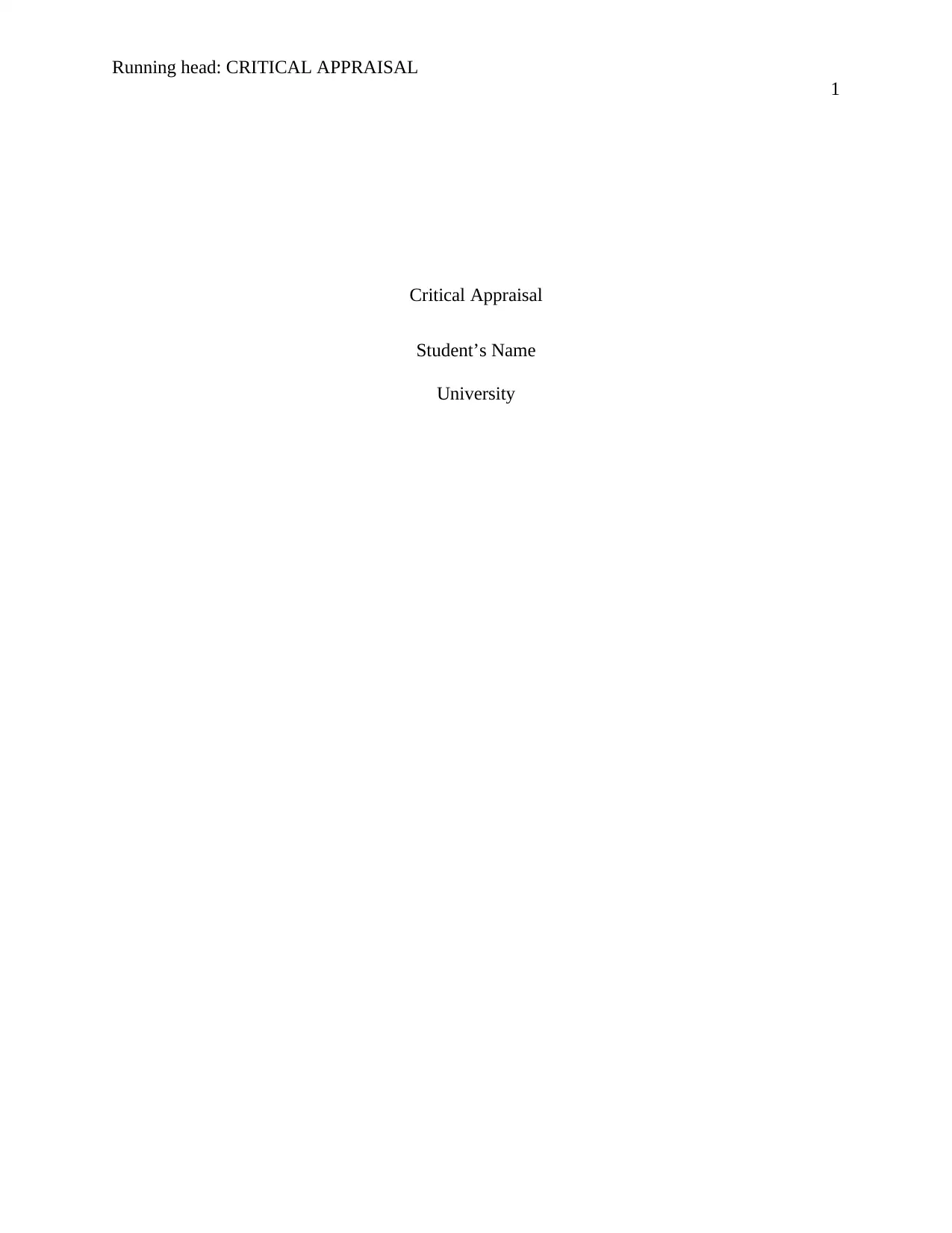
Running head: CRITICAL APPRAISAL
1
Critical Appraisal
Student’s Name
University
1
Critical Appraisal
Student’s Name
University
Paraphrase This Document
Need a fresh take? Get an instant paraphrase of this document with our AI Paraphraser
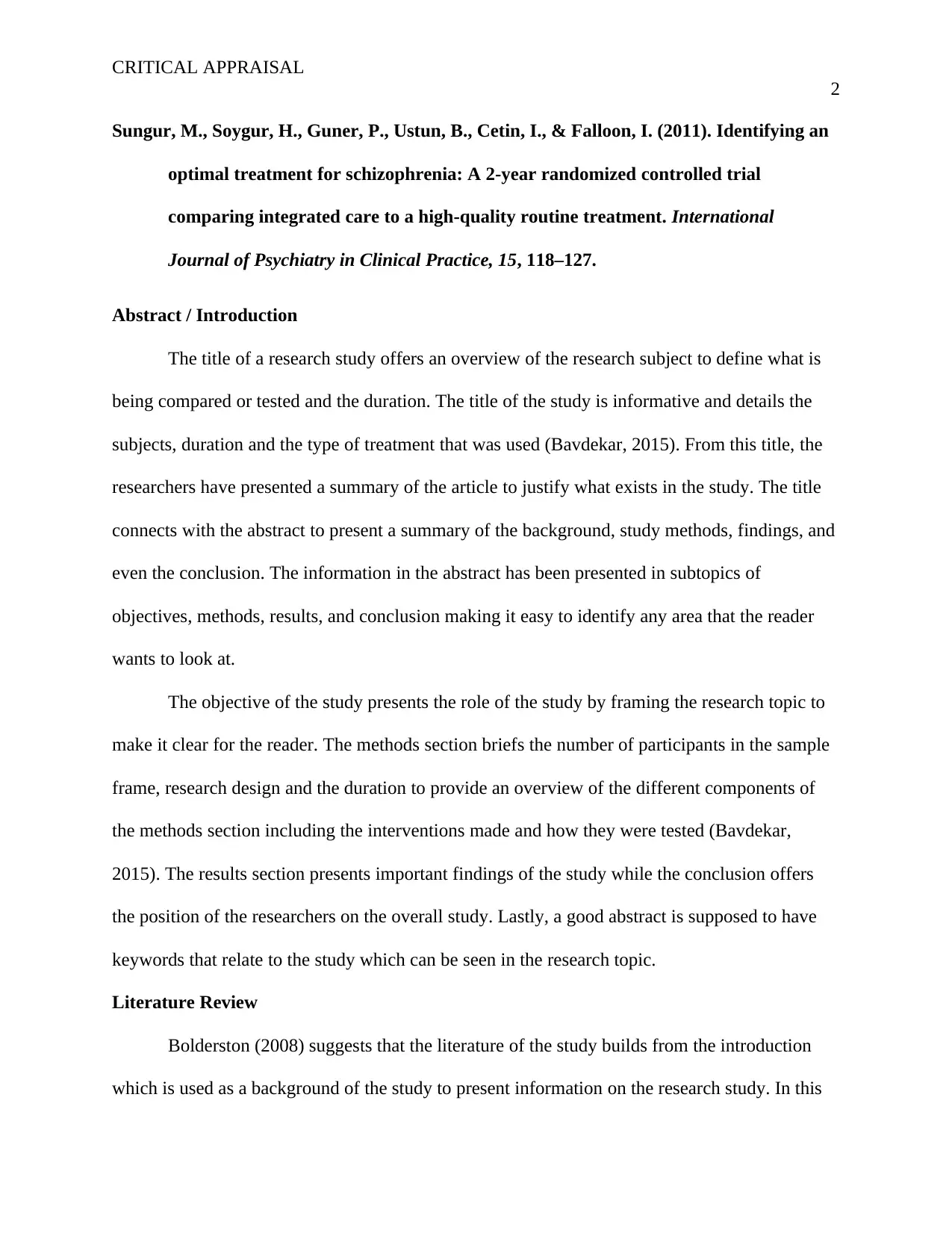
CRITICAL APPRAISAL
2
Sungur, M., Soygur, H., Guner, P., Ustun, B., Cetin, I., & Falloon, I. (2011). Identifying an
optimal treatment for schizophrenia: A 2-year randomized controlled trial
comparing integrated care to a high-quality routine treatment. International
Journal of Psychiatry in Clinical Practice, 15, 118–127.
Abstract / Introduction
The title of a research study offers an overview of the research subject to define what is
being compared or tested and the duration. The title of the study is informative and details the
subjects, duration and the type of treatment that was used (Bavdekar, 2015). From this title, the
researchers have presented a summary of the article to justify what exists in the study. The title
connects with the abstract to present a summary of the background, study methods, findings, and
even the conclusion. The information in the abstract has been presented in subtopics of
objectives, methods, results, and conclusion making it easy to identify any area that the reader
wants to look at.
The objective of the study presents the role of the study by framing the research topic to
make it clear for the reader. The methods section briefs the number of participants in the sample
frame, research design and the duration to provide an overview of the different components of
the methods section including the interventions made and how they were tested (Bavdekar,
2015). The results section presents important findings of the study while the conclusion offers
the position of the researchers on the overall study. Lastly, a good abstract is supposed to have
keywords that relate to the study which can be seen in the research topic.
Literature Review
Bolderston (2008) suggests that the literature of the study builds from the introduction
which is used as a background of the study to present information on the research study. In this
2
Sungur, M., Soygur, H., Guner, P., Ustun, B., Cetin, I., & Falloon, I. (2011). Identifying an
optimal treatment for schizophrenia: A 2-year randomized controlled trial
comparing integrated care to a high-quality routine treatment. International
Journal of Psychiatry in Clinical Practice, 15, 118–127.
Abstract / Introduction
The title of a research study offers an overview of the research subject to define what is
being compared or tested and the duration. The title of the study is informative and details the
subjects, duration and the type of treatment that was used (Bavdekar, 2015). From this title, the
researchers have presented a summary of the article to justify what exists in the study. The title
connects with the abstract to present a summary of the background, study methods, findings, and
even the conclusion. The information in the abstract has been presented in subtopics of
objectives, methods, results, and conclusion making it easy to identify any area that the reader
wants to look at.
The objective of the study presents the role of the study by framing the research topic to
make it clear for the reader. The methods section briefs the number of participants in the sample
frame, research design and the duration to provide an overview of the different components of
the methods section including the interventions made and how they were tested (Bavdekar,
2015). The results section presents important findings of the study while the conclusion offers
the position of the researchers on the overall study. Lastly, a good abstract is supposed to have
keywords that relate to the study which can be seen in the research topic.
Literature Review
Bolderston (2008) suggests that the literature of the study builds from the introduction
which is used as a background of the study to present information on the research study. In this
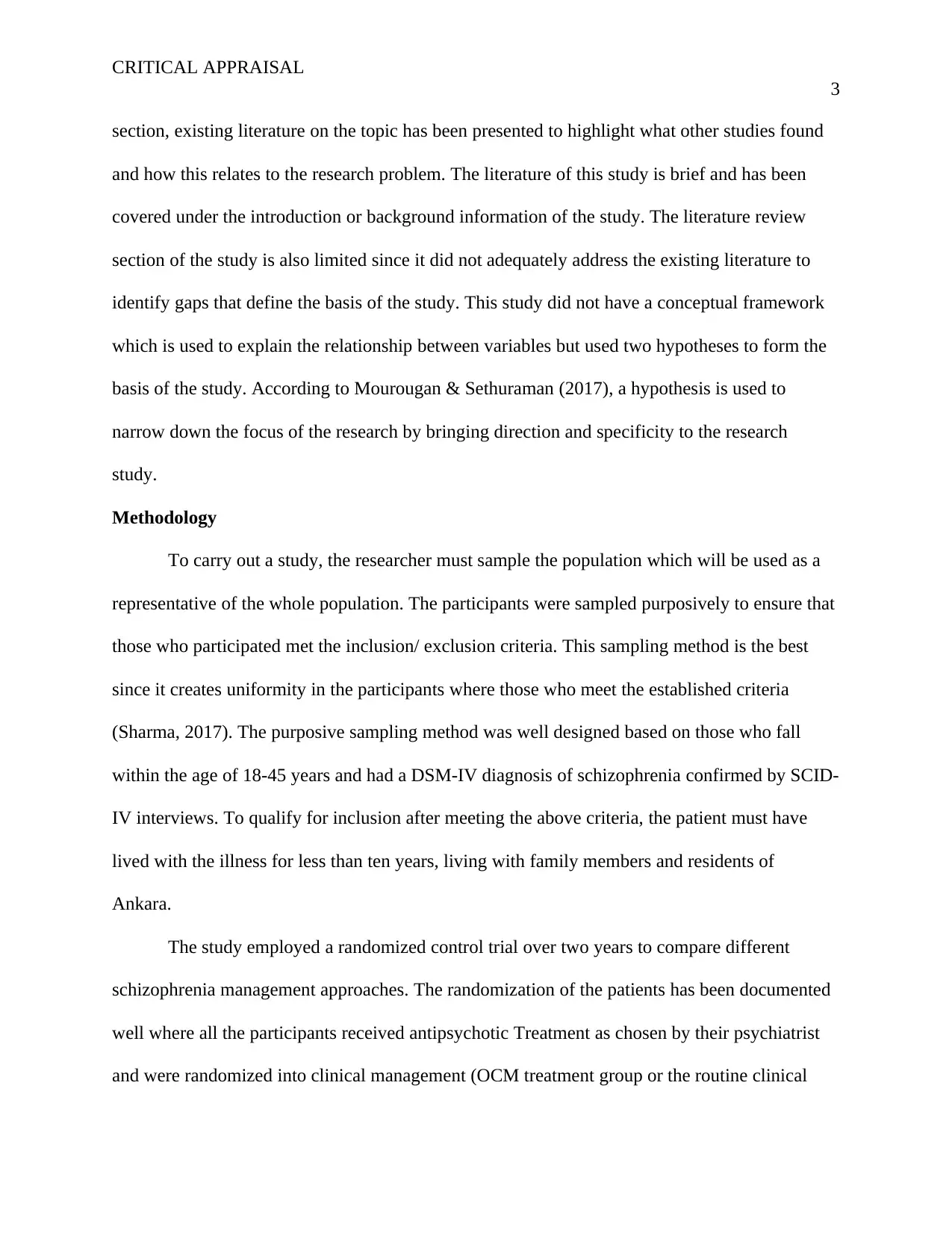
CRITICAL APPRAISAL
3
section, existing literature on the topic has been presented to highlight what other studies found
and how this relates to the research problem. The literature of this study is brief and has been
covered under the introduction or background information of the study. The literature review
section of the study is also limited since it did not adequately address the existing literature to
identify gaps that define the basis of the study. This study did not have a conceptual framework
which is used to explain the relationship between variables but used two hypotheses to form the
basis of the study. According to Mourougan & Sethuraman (2017), a hypothesis is used to
narrow down the focus of the research by bringing direction and specificity to the research
study.
Methodology
To carry out a study, the researcher must sample the population which will be used as a
representative of the whole population. The participants were sampled purposively to ensure that
those who participated met the inclusion/ exclusion criteria. This sampling method is the best
since it creates uniformity in the participants where those who meet the established criteria
(Sharma, 2017). The purposive sampling method was well designed based on those who fall
within the age of 18-45 years and had a DSM-IV diagnosis of schizophrenia confirmed by SCID-
IV interviews. To qualify for inclusion after meeting the above criteria, the patient must have
lived with the illness for less than ten years, living with family members and residents of
Ankara.
The study employed a randomized control trial over two years to compare different
schizophrenia management approaches. The randomization of the patients has been documented
well where all the participants received antipsychotic Treatment as chosen by their psychiatrist
and were randomized into clinical management (OCM treatment group or the routine clinical
3
section, existing literature on the topic has been presented to highlight what other studies found
and how this relates to the research problem. The literature of this study is brief and has been
covered under the introduction or background information of the study. The literature review
section of the study is also limited since it did not adequately address the existing literature to
identify gaps that define the basis of the study. This study did not have a conceptual framework
which is used to explain the relationship between variables but used two hypotheses to form the
basis of the study. According to Mourougan & Sethuraman (2017), a hypothesis is used to
narrow down the focus of the research by bringing direction and specificity to the research
study.
Methodology
To carry out a study, the researcher must sample the population which will be used as a
representative of the whole population. The participants were sampled purposively to ensure that
those who participated met the inclusion/ exclusion criteria. This sampling method is the best
since it creates uniformity in the participants where those who meet the established criteria
(Sharma, 2017). The purposive sampling method was well designed based on those who fall
within the age of 18-45 years and had a DSM-IV diagnosis of schizophrenia confirmed by SCID-
IV interviews. To qualify for inclusion after meeting the above criteria, the patient must have
lived with the illness for less than ten years, living with family members and residents of
Ankara.
The study employed a randomized control trial over two years to compare different
schizophrenia management approaches. The randomization of the patients has been documented
well where all the participants received antipsychotic Treatment as chosen by their psychiatrist
and were randomized into clinical management (OCM treatment group or the routine clinical
⊘ This is a preview!⊘
Do you want full access?
Subscribe today to unlock all pages.

Trusted by 1+ million students worldwide
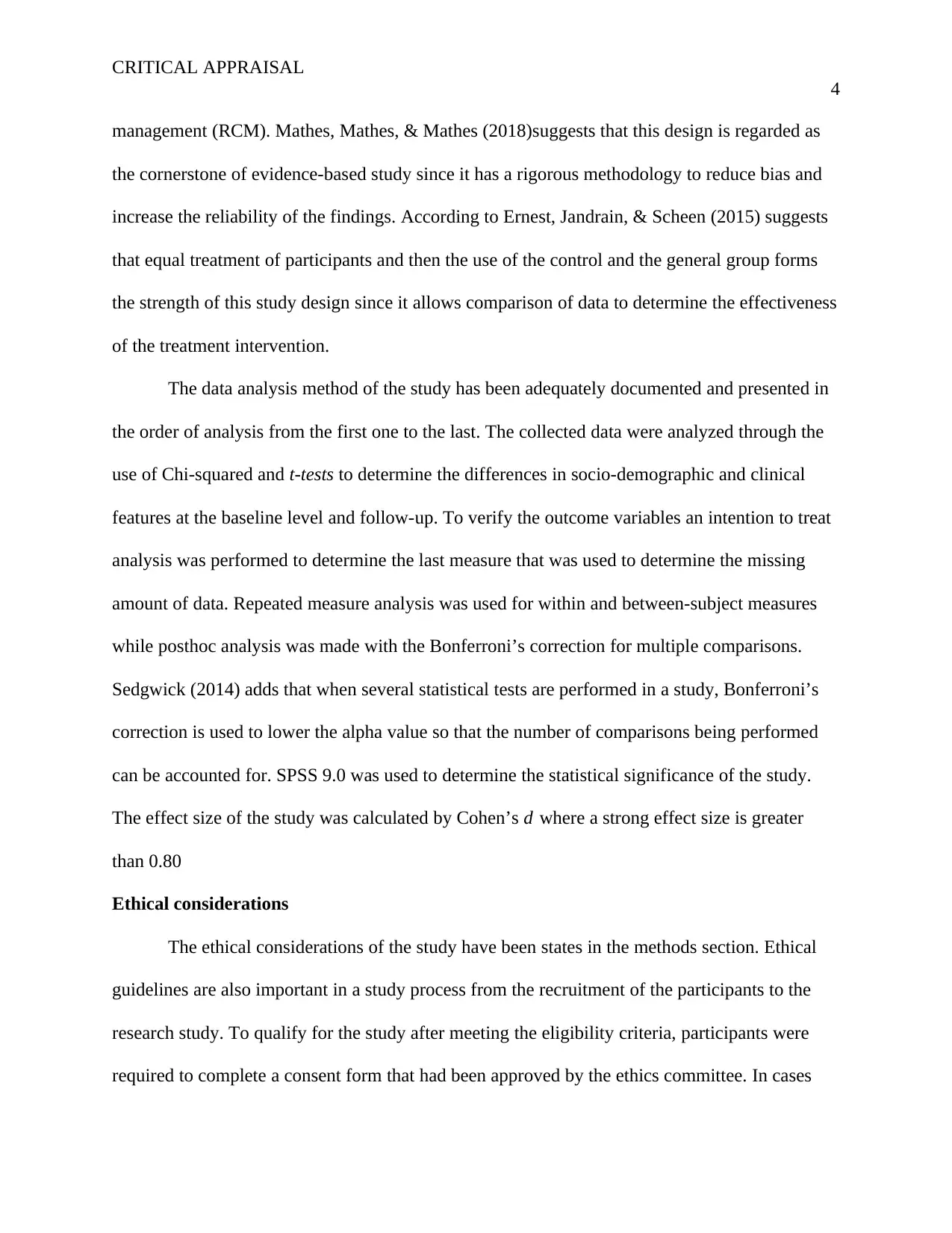
CRITICAL APPRAISAL
4
management (RCM). Mathes, Mathes, & Mathes (2018)suggests that this design is regarded as
the cornerstone of evidence-based study since it has a rigorous methodology to reduce bias and
increase the reliability of the findings. According to Ernest, Jandrain, & Scheen (2015) suggests
that equal treatment of participants and then the use of the control and the general group forms
the strength of this study design since it allows comparison of data to determine the effectiveness
of the treatment intervention.
The data analysis method of the study has been adequately documented and presented in
the order of analysis from the first one to the last. The collected data were analyzed through the
use of Chi-squared and t-tests to determine the differences in socio-demographic and clinical
features at the baseline level and follow-up. To verify the outcome variables an intention to treat
analysis was performed to determine the last measure that was used to determine the missing
amount of data. Repeated measure analysis was used for within and between-subject measures
while posthoc analysis was made with the Bonferroni’s correction for multiple comparisons.
Sedgwick (2014) adds that when several statistical tests are performed in a study, Bonferroni’s
correction is used to lower the alpha value so that the number of comparisons being performed
can be accounted for. SPSS 9.0 was used to determine the statistical significance of the study.
The effect size of the study was calculated by Cohen’s d where a strong effect size is greater
than 0.80
Ethical considerations
The ethical considerations of the study have been states in the methods section. Ethical
guidelines are also important in a study process from the recruitment of the participants to the
research study. To qualify for the study after meeting the eligibility criteria, participants were
required to complete a consent form that had been approved by the ethics committee. In cases
4
management (RCM). Mathes, Mathes, & Mathes (2018)suggests that this design is regarded as
the cornerstone of evidence-based study since it has a rigorous methodology to reduce bias and
increase the reliability of the findings. According to Ernest, Jandrain, & Scheen (2015) suggests
that equal treatment of participants and then the use of the control and the general group forms
the strength of this study design since it allows comparison of data to determine the effectiveness
of the treatment intervention.
The data analysis method of the study has been adequately documented and presented in
the order of analysis from the first one to the last. The collected data were analyzed through the
use of Chi-squared and t-tests to determine the differences in socio-demographic and clinical
features at the baseline level and follow-up. To verify the outcome variables an intention to treat
analysis was performed to determine the last measure that was used to determine the missing
amount of data. Repeated measure analysis was used for within and between-subject measures
while posthoc analysis was made with the Bonferroni’s correction for multiple comparisons.
Sedgwick (2014) adds that when several statistical tests are performed in a study, Bonferroni’s
correction is used to lower the alpha value so that the number of comparisons being performed
can be accounted for. SPSS 9.0 was used to determine the statistical significance of the study.
The effect size of the study was calculated by Cohen’s d where a strong effect size is greater
than 0.80
Ethical considerations
The ethical considerations of the study have been states in the methods section. Ethical
guidelines are also important in a study process from the recruitment of the participants to the
research study. To qualify for the study after meeting the eligibility criteria, participants were
required to complete a consent form that had been approved by the ethics committee. In cases
Paraphrase This Document
Need a fresh take? Get an instant paraphrase of this document with our AI Paraphraser
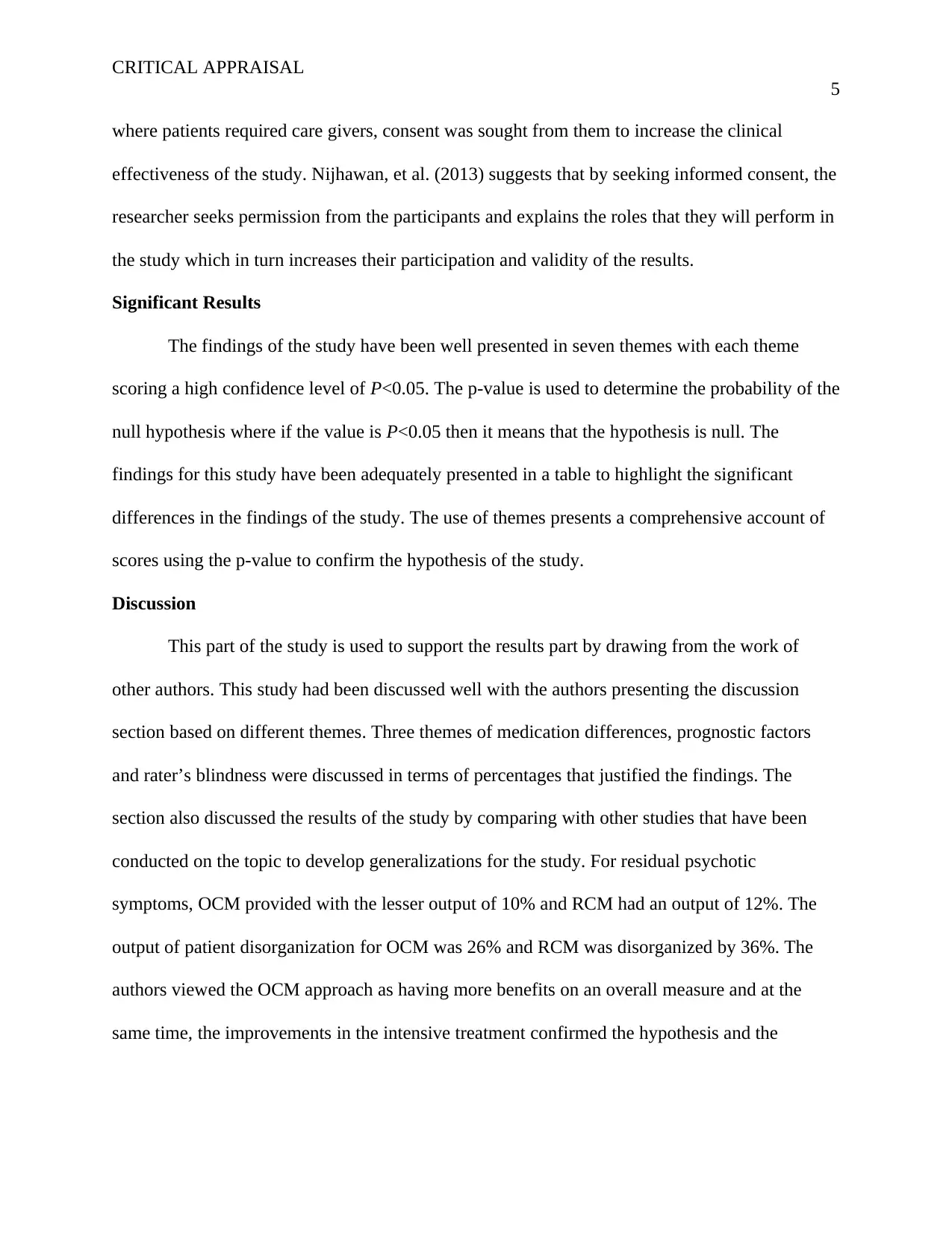
CRITICAL APPRAISAL
5
where patients required care givers, consent was sought from them to increase the clinical
effectiveness of the study. Nijhawan, et al. (2013) suggests that by seeking informed consent, the
researcher seeks permission from the participants and explains the roles that they will perform in
the study which in turn increases their participation and validity of the results.
Significant Results
The findings of the study have been well presented in seven themes with each theme
scoring a high confidence level of P<0.05. The p-value is used to determine the probability of the
null hypothesis where if the value is P<0.05 then it means that the hypothesis is null. The
findings for this study have been adequately presented in a table to highlight the significant
differences in the findings of the study. The use of themes presents a comprehensive account of
scores using the p-value to confirm the hypothesis of the study.
Discussion
This part of the study is used to support the results part by drawing from the work of
other authors. This study had been discussed well with the authors presenting the discussion
section based on different themes. Three themes of medication differences, prognostic factors
and rater’s blindness were discussed in terms of percentages that justified the findings. The
section also discussed the results of the study by comparing with other studies that have been
conducted on the topic to develop generalizations for the study. For residual psychotic
symptoms, OCM provided with the lesser output of 10% and RCM had an output of 12%. The
output of patient disorganization for OCM was 26% and RCM was disorganized by 36%. The
authors viewed the OCM approach as having more benefits on an overall measure and at the
same time, the improvements in the intensive treatment confirmed the hypothesis and the
5
where patients required care givers, consent was sought from them to increase the clinical
effectiveness of the study. Nijhawan, et al. (2013) suggests that by seeking informed consent, the
researcher seeks permission from the participants and explains the roles that they will perform in
the study which in turn increases their participation and validity of the results.
Significant Results
The findings of the study have been well presented in seven themes with each theme
scoring a high confidence level of P<0.05. The p-value is used to determine the probability of the
null hypothesis where if the value is P<0.05 then it means that the hypothesis is null. The
findings for this study have been adequately presented in a table to highlight the significant
differences in the findings of the study. The use of themes presents a comprehensive account of
scores using the p-value to confirm the hypothesis of the study.
Discussion
This part of the study is used to support the results part by drawing from the work of
other authors. This study had been discussed well with the authors presenting the discussion
section based on different themes. Three themes of medication differences, prognostic factors
and rater’s blindness were discussed in terms of percentages that justified the findings. The
section also discussed the results of the study by comparing with other studies that have been
conducted on the topic to develop generalizations for the study. For residual psychotic
symptoms, OCM provided with the lesser output of 10% and RCM had an output of 12%. The
output of patient disorganization for OCM was 26% and RCM was disorganized by 36%. The
authors viewed the OCM approach as having more benefits on an overall measure and at the
same time, the improvements in the intensive treatment confirmed the hypothesis and the
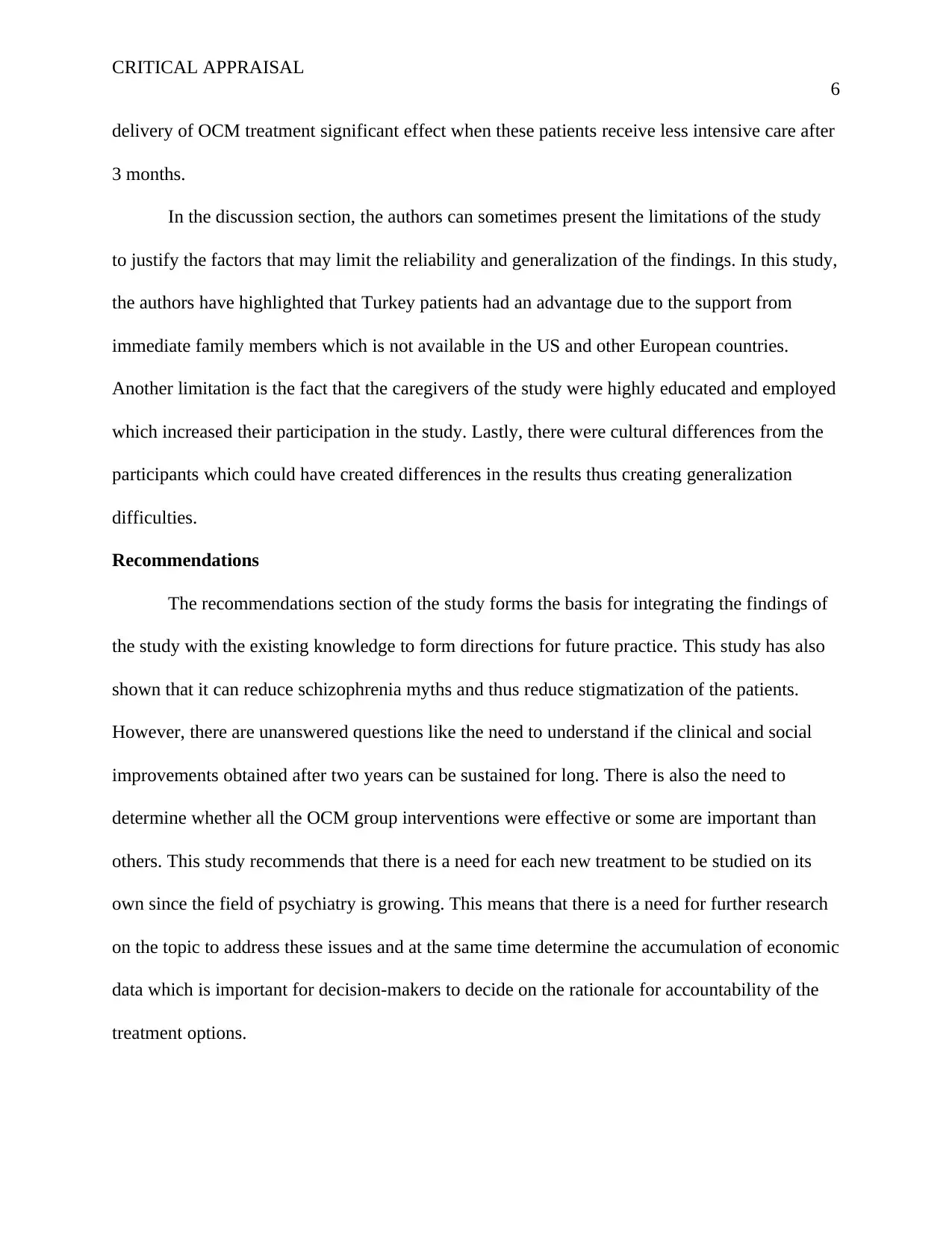
CRITICAL APPRAISAL
6
delivery of OCM treatment significant effect when these patients receive less intensive care after
3 months.
In the discussion section, the authors can sometimes present the limitations of the study
to justify the factors that may limit the reliability and generalization of the findings. In this study,
the authors have highlighted that Turkey patients had an advantage due to the support from
immediate family members which is not available in the US and other European countries.
Another limitation is the fact that the caregivers of the study were highly educated and employed
which increased their participation in the study. Lastly, there were cultural differences from the
participants which could have created differences in the results thus creating generalization
difficulties.
Recommendations
The recommendations section of the study forms the basis for integrating the findings of
the study with the existing knowledge to form directions for future practice. This study has also
shown that it can reduce schizophrenia myths and thus reduce stigmatization of the patients.
However, there are unanswered questions like the need to understand if the clinical and social
improvements obtained after two years can be sustained for long. There is also the need to
determine whether all the OCM group interventions were effective or some are important than
others. This study recommends that there is a need for each new treatment to be studied on its
own since the field of psychiatry is growing. This means that there is a need for further research
on the topic to address these issues and at the same time determine the accumulation of economic
data which is important for decision-makers to decide on the rationale for accountability of the
treatment options.
6
delivery of OCM treatment significant effect when these patients receive less intensive care after
3 months.
In the discussion section, the authors can sometimes present the limitations of the study
to justify the factors that may limit the reliability and generalization of the findings. In this study,
the authors have highlighted that Turkey patients had an advantage due to the support from
immediate family members which is not available in the US and other European countries.
Another limitation is the fact that the caregivers of the study were highly educated and employed
which increased their participation in the study. Lastly, there were cultural differences from the
participants which could have created differences in the results thus creating generalization
difficulties.
Recommendations
The recommendations section of the study forms the basis for integrating the findings of
the study with the existing knowledge to form directions for future practice. This study has also
shown that it can reduce schizophrenia myths and thus reduce stigmatization of the patients.
However, there are unanswered questions like the need to understand if the clinical and social
improvements obtained after two years can be sustained for long. There is also the need to
determine whether all the OCM group interventions were effective or some are important than
others. This study recommends that there is a need for each new treatment to be studied on its
own since the field of psychiatry is growing. This means that there is a need for further research
on the topic to address these issues and at the same time determine the accumulation of economic
data which is important for decision-makers to decide on the rationale for accountability of the
treatment options.
⊘ This is a preview!⊘
Do you want full access?
Subscribe today to unlock all pages.

Trusted by 1+ million students worldwide
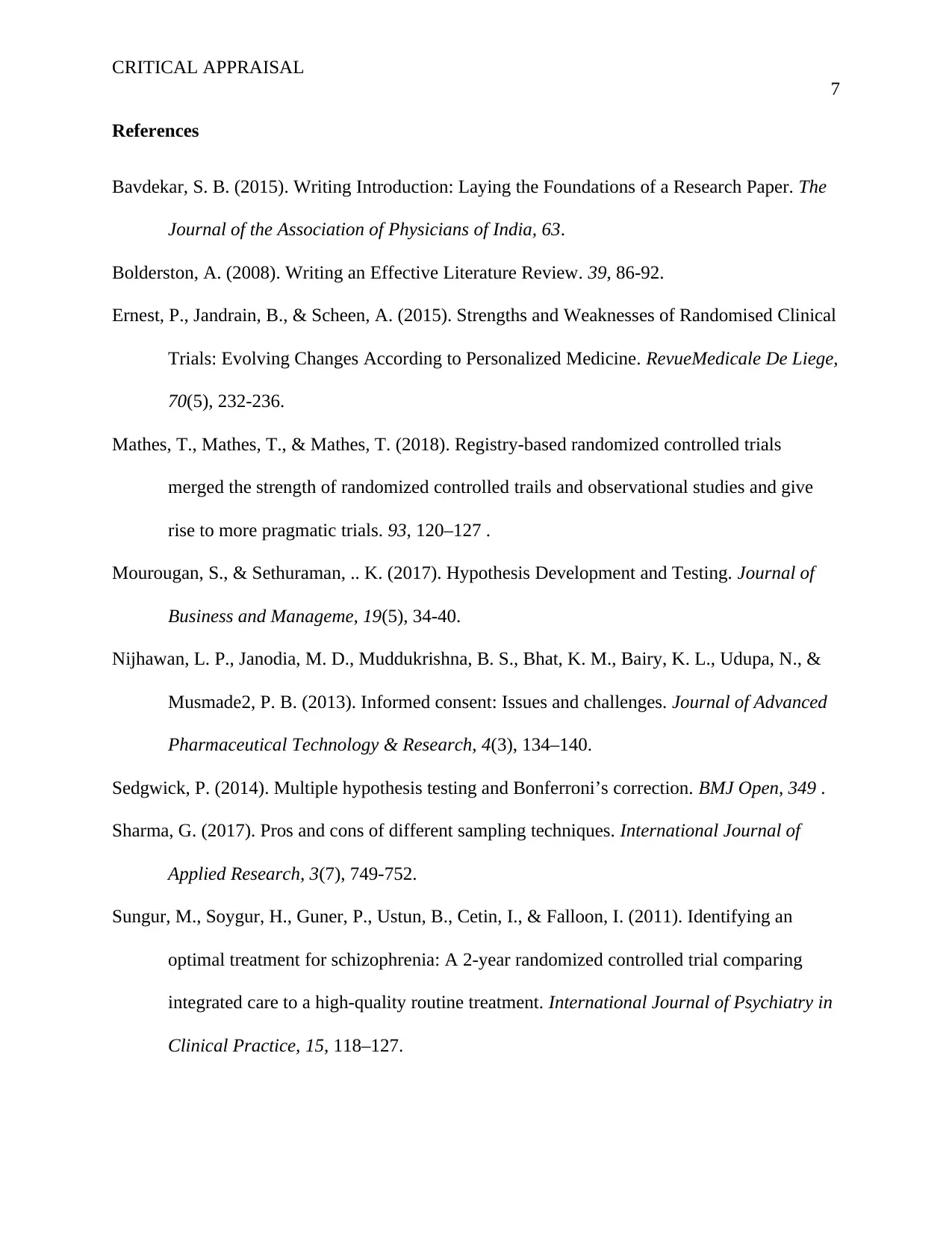
CRITICAL APPRAISAL
7
References
Bavdekar, S. B. (2015). Writing Introduction: Laying the Foundations of a Research Paper. The
Journal of the Association of Physicians of India, 63.
Bolderston, A. (2008). Writing an Effective Literature Review. 39, 86-92.
Ernest, P., Jandrain, B., & Scheen, A. (2015). Strengths and Weaknesses of Randomised Clinical
Trials: Evolving Changes According to Personalized Medicine. RevueMedicale De Liege,
70(5), 232-236.
Mathes, T., Mathes, T., & Mathes, T. (2018). Registry-based randomized controlled trials
merged the strength of randomized controlled trails and observational studies and give
rise to more pragmatic trials. 93, 120–127 .
Mourougan, S., & Sethuraman, .. K. (2017). Hypothesis Development and Testing. Journal of
Business and Manageme, 19(5), 34-40.
Nijhawan, L. P., Janodia, M. D., Muddukrishna, B. S., Bhat, K. M., Bairy, K. L., Udupa, N., &
Musmade2, P. B. (2013). Informed consent: Issues and challenges. Journal of Advanced
Pharmaceutical Technology & Research, 4(3), 134–140.
Sedgwick, P. (2014). Multiple hypothesis testing and Bonferroni’s correction. BMJ Open, 349 .
Sharma, G. (2017). Pros and cons of different sampling techniques. International Journal of
Applied Research, 3(7), 749-752.
Sungur, M., Soygur, H., Guner, P., Ustun, B., Cetin, I., & Falloon, I. (2011). Identifying an
optimal treatment for schizophrenia: A 2-year randomized controlled trial comparing
integrated care to a high-quality routine treatment. International Journal of Psychiatry in
Clinical Practice, 15, 118–127.
7
References
Bavdekar, S. B. (2015). Writing Introduction: Laying the Foundations of a Research Paper. The
Journal of the Association of Physicians of India, 63.
Bolderston, A. (2008). Writing an Effective Literature Review. 39, 86-92.
Ernest, P., Jandrain, B., & Scheen, A. (2015). Strengths and Weaknesses of Randomised Clinical
Trials: Evolving Changes According to Personalized Medicine. RevueMedicale De Liege,
70(5), 232-236.
Mathes, T., Mathes, T., & Mathes, T. (2018). Registry-based randomized controlled trials
merged the strength of randomized controlled trails and observational studies and give
rise to more pragmatic trials. 93, 120–127 .
Mourougan, S., & Sethuraman, .. K. (2017). Hypothesis Development and Testing. Journal of
Business and Manageme, 19(5), 34-40.
Nijhawan, L. P., Janodia, M. D., Muddukrishna, B. S., Bhat, K. M., Bairy, K. L., Udupa, N., &
Musmade2, P. B. (2013). Informed consent: Issues and challenges. Journal of Advanced
Pharmaceutical Technology & Research, 4(3), 134–140.
Sedgwick, P. (2014). Multiple hypothesis testing and Bonferroni’s correction. BMJ Open, 349 .
Sharma, G. (2017). Pros and cons of different sampling techniques. International Journal of
Applied Research, 3(7), 749-752.
Sungur, M., Soygur, H., Guner, P., Ustun, B., Cetin, I., & Falloon, I. (2011). Identifying an
optimal treatment for schizophrenia: A 2-year randomized controlled trial comparing
integrated care to a high-quality routine treatment. International Journal of Psychiatry in
Clinical Practice, 15, 118–127.
Paraphrase This Document
Need a fresh take? Get an instant paraphrase of this document with our AI Paraphraser

CRITICAL APPRAISAL
8
8
1 out of 8
Related Documents
Your All-in-One AI-Powered Toolkit for Academic Success.
+13062052269
info@desklib.com
Available 24*7 on WhatsApp / Email
![[object Object]](/_next/static/media/star-bottom.7253800d.svg)
Unlock your academic potential
Copyright © 2020–2025 A2Z Services. All Rights Reserved. Developed and managed by ZUCOL.





